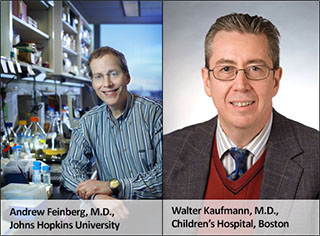


Posted April 22, 2014
Andrew Feinberg, M.D., Johns Hopkins University, Walter Kaufmann, M.D., Children's Hospital, Boston
 Environmental factors may play a large role in autism pathogenesis. This is supported by the fact that the disorder may be present in only one identical, or monozygotic, twin. While the precise mechanisms behind this are largely unknown, it is possible that epigenetic factors, or the external alteration of DNA that can turn a gene on or off, contribute to the onset of autism. Dr. Andrew Feinberg from Johns Hopkins University and Dr. Walter Kaufmann from Children's Hospital Boston received a Fiscal Year 2008 Autism Research Program Synergistic Idea Award to study epigenetic abnormalities that contribute to the etiology (cause) of autism. For their study population, Drs. Feinberg and Kaufmann used discordant pairs of identical twins in which one twin had autism and the other did not. They hypothesized that "since these individuals share the same genetic sequence, there must be other factors involved in the development of autism," such as epigenetic changes to the genome. Through this study, they discovered regions of the genome that showed differences in gene methylation, an epigenetic chemical modification of DNA, between the discordant twins.
Environmental factors may play a large role in autism pathogenesis. This is supported by the fact that the disorder may be present in only one identical, or monozygotic, twin. While the precise mechanisms behind this are largely unknown, it is possible that epigenetic factors, or the external alteration of DNA that can turn a gene on or off, contribute to the onset of autism. Dr. Andrew Feinberg from Johns Hopkins University and Dr. Walter Kaufmann from Children's Hospital Boston received a Fiscal Year 2008 Autism Research Program Synergistic Idea Award to study epigenetic abnormalities that contribute to the etiology (cause) of autism. For their study population, Drs. Feinberg and Kaufmann used discordant pairs of identical twins in which one twin had autism and the other did not. They hypothesized that "since these individuals share the same genetic sequence, there must be other factors involved in the development of autism," such as epigenetic changes to the genome. Through this study, they discovered regions of the genome that showed differences in gene methylation, an epigenetic chemical modification of DNA, between the discordant twins.
This study provides a strong foundation for further investigation into the role of epigenetics in autism. For the next step in their research, Drs. Feinberg and Kaufmann plan to use a larger study population to confirm their findings and determine how frequently the abnormal DNA methylation patterns occur in individuals with autism. Further, they plan to study the function of the genes that are methylated and to identify the environmental or other factors that lead to these methylation changes in autistic individuals. Results from these studies could help in the early detection of autism through identification of at risk families, prenatal analysis, or early postnatal diagnosis, which would allow for early intervention implementation. In addition, since DNA methylation is potentially reversible, this research could lead to treatment options for individuals with autism.
Publications:
Montano CM, Irizarry RA, Kaufmann WE, et al. 2013. Measuring cell-type specific differential methylation in human brain tissue. Genome Biol 14:R94.
Ladd-Acosta C, Hansen KD, Briem E, et al. 2013. Common DNA methylation alterations in multiple brain regions in autism. Mol Psychiatry (Epub ahead of print).
Links:
Abstracts for Dr. Feinberg
Public and Technical Abstracts: Discordant Monozygotic Twins as a Model for Genetic-Environmental Interaction in Autism
Abstracts for Dr. Kauffman
Public and Technical Abstracts: Discordant Monozygotic Twins as a Model for Genetic-Environmental Interaction in Autism














